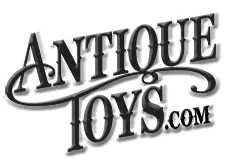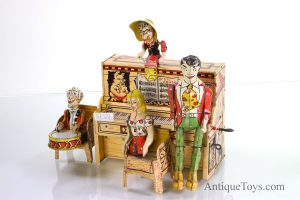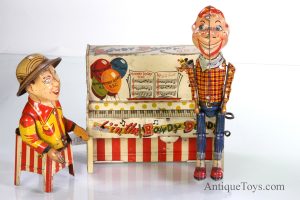Piano Band Toys from Strauss and Unique Art- Ham & Sam, Howdy Doody, and Li’l Abner
Ask a kid today about a piano and they will ask about what video game or phone ap you are talking about. They may ask you about which Casio style keyboard you are speaking of. Remotely, they may know about full sized pianos.
Pianos used to be a a core of American life in the early 20th century, and well heeled families had a member that could read music. Then kids and relatives would gather in the evenings and sing along or simply enjoy piano music. Rich folks, if you will, had player pianos to cheat and get the perfect notes with the perfect timing. They had a paper scroll of punched holes to automatically play the notes. There was no TV. In the early 20th century there was limited radio or no reception. There weren’t CD players, mp3 files, tape players, etc. and it was a challenge to get music “on the fly”. It was a treat to hear a piano performance.
So try to beam yourself back in time and think about piano toys with this mindset. It was a big thing and a cherished item. In this frame of mind we can gain an appreciation for early Strauss and Unique Art piano and band toys. Our earliest toy used the black American theme of minstrel dancers, then we evolve to Comic toys like Li’l Abner and the Dogpatch windup. Later the post war rage was Howdy Doodie and its radio and TV branding. Howdy Doody is the perfect example of the pre-radio to radio to TV transition of entertainment. Our glossy piano toy for Howdy is the final incarnation we review.
Early pre-TV toy maker Ferdinand Strauss was based in New York, New York in the early 20th Century. Some of the Strauss toys are marked made in USA, and others were likely imported. Their logo was “Strauss toys, known the world over”. Strauss made our Ham and Sam toy and it predates a company we are more familiar with- The Ferdinand Marx tin company. In fact Marx actually worked as a salesman for Strauss about the time Ham and Sam was produced. Strauss lasted from about 1914 to 1927. The Great Depression took its toll.
If these Strauss toys look similar to Marx, well Ferdinand Strauss was the earliest manufacturer of these tin mechanical toys. When it was in financial trouble, Louis Marx purchased in 1922 along with toy dies. Louis Marx started his career working at Ferdinand Strauss at the age of 14.
Strauss’ Ham and Sam player piano (with minstrel team) is our oldest featured toy. Records date this toy from about 1921. Minstrel teams were often racially charged performers, sometimes white people with black face paint or at times black performers on tour. Early acts of white men going “black faced” trace back to the 1840’s by performers such as Billy Whitlock and Billy Pelham and had popularity for at least 60 more years. Later, post Civil War times, black men become more common in these minstrel shows.
George Borgfeldt, “Sole distributor for Ferdinand Strauss toys”, noted this toy as Number 95 in their 1924 catalog. It retailed at $1.00.
Unique Art, maker of Howdy Doodie and Dogpatch Band toys, had its roots in Newark, New Jersey. Around 1916 Unique Art first began making tin boxes for products and simple toys. Later the toys added more features and movements using windup mechanisms. One of its early products was a wind-up toy featuring two tin boxers. In the 1930’s they produced a very collectible Lincoln Tunnel (NYC) that involved moving cars, a bridge, and wonderful lithography bringing the scene all together. Around 1944, the company stamped “G.I. Joe” onto figures and Jeep toys; Hasbro may have noted the great branding.
Little or Li’l Abner and the Dog Patch Band toy harkens from around 1941 and shows the most features of this set of three. The toy is copyright 1945 by United Features Syndicate Inc and made by Unique Art Manufacturing Co, Inc. “Pioneer Toy Makers Since 1916″ of Newark, J.J. Characters came from the namesake comic and lived in the impoverished mountain village of Dogpatch, USA. In our toy the Drummer taps out three notes, then a rest, then three notes. The Jigg of the Li’l Abner Yokum ( 6′ 3” little guy) is a similar three step, pause, three step dance. Only his movement is less dependable with flexible knees and arms adding some variety. Grandma (smoking a pipe) is atop directing with longer strokes of the baton each measure. Daisy Mae Yokum herself sways from side to side at the waste. Her arms rotate in a way that makes her appear to play two notes a bar.
As an added bonus, the back of the piano has a nice image of “Olman Mose”. “Coleman Mose Lives Here Quite Pleaz” . On the Side there are chicks and Eggs or “Aigs”. cute. Finally, on the side is a poster for “Sadie Hawkins Day Coming”. There is a gastly looking gal and” Ef a Gal Ketches Yo’ then Yo’re Hern”. Gas!
From 1947 to 1960, American kids had a taste of the Howdy Doody show in black and white TV, then new RCA color TV. Our Howdy Doody windup taps into this kids craze. Bob Smith created Howdy Doody during his days as a radio announcer on WNBC. At that time, Howdy Doody was only a voice Smith performed on the radio. When Smith made an appearance on NBC’s television program Puppet Playhouse on December 27, 1947, the reception for the character was great enough to begin a demand for a visual character for television. Frank Paris, a puppeteer whose puppets appeared on the programme, was asked to create a Howdy Doody puppet.
Our toy depicts the show’s creator “Buffalo Bob” at the piano and a dancing Howdy Doody puppet. Unique Art Manufacturing began producing toys in Newark, New Jersy around 1916 and continued into the 1940s’.
[inpost_gallery thumb_width=”200″ thumb_height=”200″ post_id=”3700″ thumb_margin_left=”0″ thumb_margin_bottom=”0″ thumb_border_radius=”2″ thumb_shadow=”0 1px 4px rgba(0, 0, 0, 0.2)” js_play_delay=”3000″ id=”” random=”0″ group=”0″ border=”” type=”yoxview” show_in_popup=”0″ album_cover=”” album_cover_width=”200″ album_cover_height=”200″ popup_width=”800″ popup_max_height=”600″ popup_title=”Gallery” sc_id=”sc1507647987190″]
So enjoy these toys for the evolutionary dead ends they are. The manufacturing is complex is costly and complex. The subject matter is outdated. However these toys capture a memorable time in American history. The TV, not the piano, is now the central means of entertainment in American family life (insert commentary here). These are iconic toys that remind us of a simpler American life.
Ed



